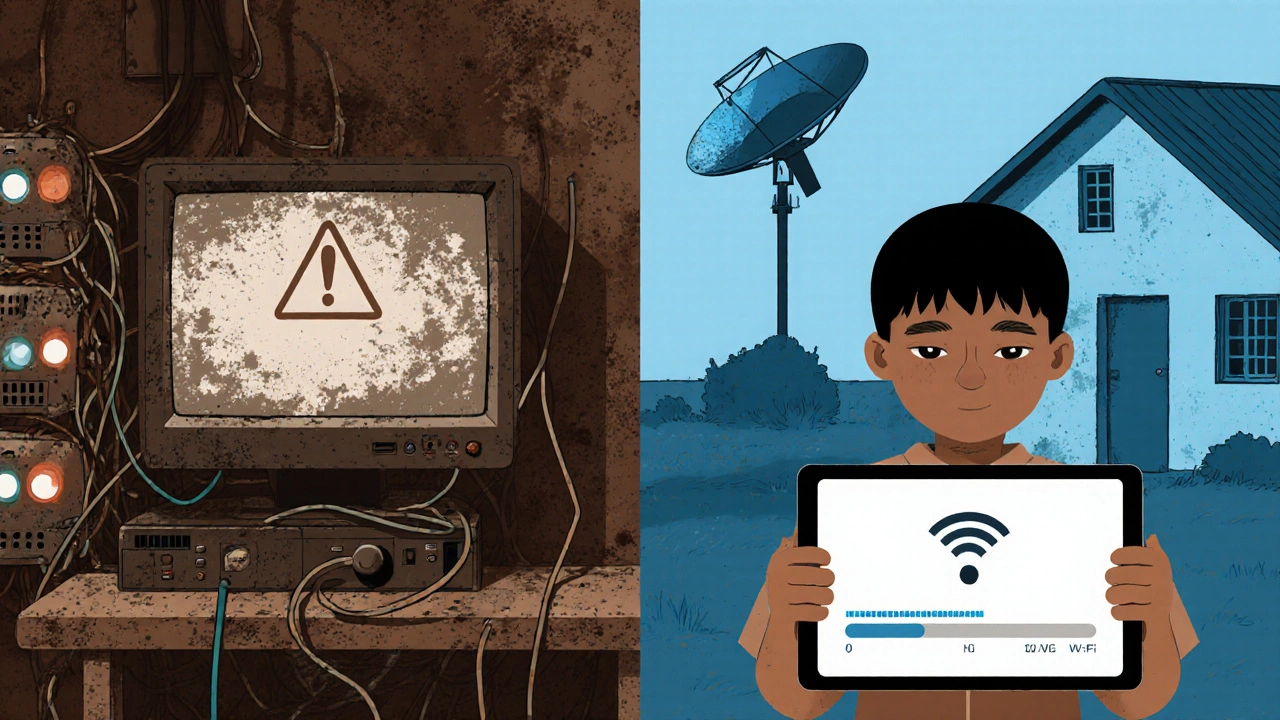
E-Learning Engagement Calculator
Current Engagement Score
Your current engagement level based on key e-learning factors.
Improvement Goal
Adjust to see how much improvement is possible.
Adjust Key Factors
Recommendations to Improve Engagement
When schools and companies shifted to digital classrooms, the promise was clear: flexible schedules, wider reach, and cost savings. Yet many learners still drop out, complain about boredom, and score lower than in face‑to‑face classes. The core issue? A massive gap in e-learning problem that keeps students from staying interested and actually learning.
What is E‑learning?
E‑learning is a mode of education that delivers content, interaction, and assessment through internet‑based platforms. It includes video lessons, quizzes, discussion boards, and live webinars, allowing learners to access material anytime, anywhere. Since its rise in the early 2000s, E‑learning has become a cornerstone for universities, corporate training, and K‑12 schools.
Why Engagement Is the Biggest Problem
Even with high‑quality videos and interactive quizzes, learners often report feeling disconnected. Studies from the 2024 Global Online Learning Survey show that 68% of students cite "lack of engagement" as the main reason they stop using a platform. When engagement drops, motivation wanes, retention rates fall, and knowledge transfer suffers.
Engagement isn’t just about fun; it’s the glue that links attention, effort, and memory. Without it, learners skim content, skip activities, and forget what they studied. The result is lower grades, higher dropout rates, and a poor ROI for institutions investing in digital education.
Technology Infrastructure Gaps
Technology infrastructure refers to the hardware, software, and network resources needed to run an online learning system. In many schools, outdated servers, limited bandwidth, and inconsistent Wi‑Fi cause video buffering, broken links, and lost progress. A 2023 audit of New Zealand secondary schools found that 42% experienced at least one major technical glitch per semester, directly correlating with lower student satisfaction.
The Digital Divide
Digital divide describes the gap between learners who have reliable internet and devices and those who don’t. Rural areas, low‑income families, and some developing regions still struggle with connectivity. When a learner can’t join a live session or download a large video, disengagement becomes inevitable.

Assessment Integrity Issues
Assessment integrity covers the fairness and security of online tests. Cheating, identity verification failures, and ambiguous grading rubrics erode trust. If students doubt the credibility of assessments, they’re less likely to take them seriously, which further reduces engagement.
Lack of Social Interaction
Social interaction in education includes peer discussions, group projects, and informal chat that reinforce learning. E‑learning platforms often replace a bustling classroom with a silent forum, leaving learners feeling isolated. Isolation fuels disengagement, especially for younger students who thrive on collaborative play.
Poor Learning Design
Learning design is the systematic planning of objectives, activities, and assessments to achieve desired outcomes. Many courses are simply digitized slides without instructional scaffolding. Without clear goals, varied media, and spaced repetition, learners lose direction and interest.
Motivation Decline Over Time
Motivation drives a learner to start and persist in a task. In self‑paced environments, intrinsic motivation must be nurtured through relevance, feedback, and autonomy. When these cues are missing, motivation drops sharply after the first week.
Comparing Synchronous and Asynchronous Challenges
| Challenge | Synchronous (Live) | Asynchronous (Self‑paced) |
|---|---|---|
| Engagement | Requires real‑time interaction; prone to “Zoom fatigue” | Often passive; learners may skip activities |
| Technical issues | Live streaming demands high bandwidth | Downloads can be scheduled for off‑peak times |
| Assessment integrity | Proctoring tools can be intrusive | Harder to verify identity on timed quizzes |
| Social interaction | Live breakout rooms foster collaboration | Forum threads may become stagnant |
| Motivation | Scheduled sessions provide structure | Self‑discipline required to stay on track |
Practical Strategies to Boost Engagement
- Chunk content: Break videos into 5‑10 minute segments and pair each with a quick poll or reflection.
- Gamify progress: Use points, badges, and leaderboards to create a sense of achievement.
- Live interaction: Schedule weekly webinars with Q&A, small‑group breakout rooms, or guest speakers.
- Peer feedback loops: Assign students to review each other's work, fostering social learning.
- Adaptive pathways: Let learners choose between multiple resources based on prior knowledge.
- Micro‑assessments: Deploy short quizzes after each chunk to reinforce memory and provide instant feedback.
- Accessible tech: Ensure all materials work on low‑bandwidth connections and mobile devices.
Checklist for Educators and Course Designers
Before launching a new module, run through this quick list:
- Did you break each lesson into bite‑size pieces?
- Is there a clear interaction point (poll, quiz, discussion) every 7‑10 minutes?
- Have you included at least one collaborative activity per week?
- Are all assets optimized for mobile and low‑speed internet?
- Do you provide a variety of assessment formats (multiple‑choice, short‑answer, project)?
- Is there a visible progress tracker for learners?
- Have you set up a feedback channel for learners to report technical or motivational issues?
Frequently Asked Questions
Why do students feel bored in online courses?
Boredom often stems from passive consumption-long videos without interaction, lack of peer collaboration, and unclear relevance to real‑world tasks. Adding interactive polls, short discussions, and real‑life case studies can re‑ignite interest.
Is technology the main cause of disengagement?
Tech problems amplify disengagement but are rarely the root cause. Even with flawless streaming, learners can still feel isolated if the course lacks social elements and purposeful design.
How can I measure engagement in my e‑learning platform?
Track metrics such as video completion rates, quiz participation, forum posts per active user, and time‑on‑task. Combine quantitative data with periodic surveys asking learners how involved they felt.
What low‑cost tools can help boost interaction?
Free tools like Kahoot! for live quizzes, Padlet for collaborative boards, and Google Meet breakout rooms work well without heavy licensing fees.
Can gamification work for professional training?
Absolutely. Awarding badges for completing compliance modules or using leaderboards for sales skill drills motivates adult learners just as it does younger students.
More Articles

Top-Paying Certifications: Unlock Your Next Big Salary Jump
Considering an online certification? It's crucial to know which ones offer the best return on investment. Some certifications not only boost your skills but can significantly increase your earnings too. This article delves into the certifications that pay the most, offering insights into fields with high demand and lucrative salaries. Armed with the right information, you'll be better equipped to make an informed decision about your education path.

Is CBSE Accepted in the USA?
Curious if the CBSE curriculum holds weight in the USA? Dive into how American universities view CBSE credentials, the application process for aspiring CBSE students, and tips for smooth transitions. Whether you're aiming for college or considering moving, understanding these points will make your path clearer.

Top English Learning Courses for Fluency and Confidence
English fluency opens doors to countless opportunities, whether for travel, career advancement, or personal growth. With a plethora of courses available, choosing the right one can be daunting. This guide explores popular options, including online platforms, in-person classes, and specialized courses. Discover tips and insights to find the perfect fit for your English learning journey.
